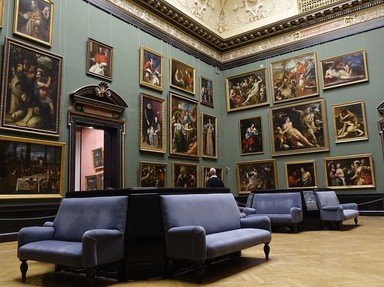Quiz Answer Key and Fun Facts
1. Located in the West Wing, this beautiful and captivating painting was created in or around 1540 to 1550 by Agnolo Bronzino. Historians believe that this masterpiece may have been presented to Francis I of France. The minute detail of the artist's hand shows greatly in a very noticeable pair of contrasting masks that rests in the lower right-hand corner of the painting. This mesmerizing painting shows the human race in happiness, greed, jealousy and, above all, love. What is the name of this painting?
2. Located in the Sainsbury Wing, this painting is believed to have been created in or around 1434 by Jan van Eyck. It shows a man and a woman, who appears to be with child, holding hands. While gazing at the painting you are sure to notice a wall mounted mirror in the background, which clearly shows an image of the couple from behind. What is the name of this painting?
3. Located in the North Wing, this painting is believed to have been created in or about 1638 by Sir Anthony van Dyck. It is shown in oil on a canvas background and reflects two men in a relaxed setting. While looking at the painting it appears as if they are in deep conversation when someone, that is not visible, calls to one of them. The detail that is shown in a pair of kid gloves that dangles freely from one of their hands, is that of a free flowing and stylistic approach. What is the name of this masterpiece?
4. Located in the West Wing, this painting was created in or about 1511 to 1512 by Raphael. It is of a man that is resting in a finely crafted wooden chair adorned with bronze acorns, and although he may look forlorn, his bejeweled hands that grip the arms of the chair show that he is relaxed, and yet there is a touch of something slightly disturbing about his personality, which is showcased by the way his left hand is clenching the left arm rest of his chair. What is the name of this painting?
5. Located in the East Wing, this painting by George Stubbs was created in or about 1762. The life sized portrait of a rearing horse with a fiery look in its eye, is considered by most historians to be Stubbs' masterpiece. The detail of the stallion on his hind legs, is enhanced with graceful and flowing symmetry and yet shows the sturdy nature and determination of the stallion. What is the name of this painting?
6. Located in the Sainsbury Wing, this painting was created in or about 1485 by Sandro Botticelli. It showcases a man who appears to be in a peaceful sleep and not even the conch shell being blown in his ear seems to arouse him; while the woman has an intense and determined look upon her, as if she is pleased and yet at the same time it seems that there is something that she is holding back. What is the name of this painting?
7. Located in the North Wing, this painting was created in or about 1609 by Peter Paul Rubens. It captures a man who is totally in love with the woman of his dreams, that he falls comfortably asleep with his head resting in her lap. The woman is cast in a beautiful light while showcasing a conniving smirk, as she entwines her fingertips in her lover's tresses. What is the name of this painting?
8. Located in the East Wing, this painting was created in or about 1826 by John Constable, and shows a lovely country road, complete with swaying trees and a small boy drinking from a nearby stream. The detail of the looming clouds above gives the appearance that a storm is brewing in the distance. What is the name of this painting?
9. Located in the Sainsbury Wing, this painting was created in or about 1496 by Albrecht Durer, and shows the exquisite detail of daylight erupting onto nearby rocky cliffs. On the right side of the painting, you will see the minute detail of a lion that appears to be resting, while his regal face holds a look of impending displeasure. What is the name of this painting?
10. Located in the North Wing, this painting was created between 1636 to 1638 by Rembrandt, and shows a group of people about to enjoy a feast, but then a light suddenly appears and startles the host and his guests. The detail shown in the hosts' vest is heavily highlighted by the design and coloring of his cape. What is the name of this painting?
Source: Author
JuniorTheJaws
This quiz was reviewed by FunTrivia editor
Bruyere before going online.
Any errors found in FunTrivia content are routinely corrected through our feedback system.

